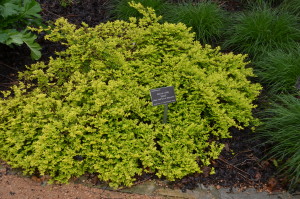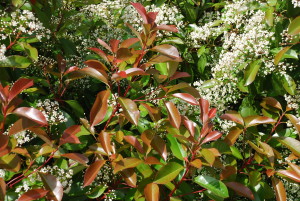To many people, maintaining a garden or landscape means a lot of hard work. Sometimes the weeds outgrow what you have planted. Some landscape plants promise a lot of beauty but deliver nothing but problems. Some trees are weak wooded, prone to pests or diseases, and outgrow their space. Some produce smelly odorous flowers. I urge you to avoid these five plants.
Callery Pears (Pyrus calleryana) grow 35 to 50 feet high. They’re labeled ‘Bradford’ or Cleveland Select’. Their weak branches make them highly prone to storm damage. The odor from spring flowers can be stifling. Older trees produce thousands of tiny pear fruit that give rise to multitudes of thorny seedlings that invade woodlands and vacant lots.
Red-tip Photinias (Photinia x fraseri) are beautiful shrubs. Their lustrous burgundy red leaves and snow white flowers will lure you into purchasing them. A small 3-4 foot plant in a #3 container may become 15 feet high and wide in less than 8 years. Bright red new leaves turn green in 4-6 weeks. By mid-summer leaves are attacked by a defacing fungus disease called Entomosporium leaf spot. Unless you spray often with a fungicide, the disease eventually kills the shrub.
Russian Olive (Eleaegnus angustifolius) is a large deciduous shrub or small tree, up to 25 feet tall. The tree forms a dense canopy with distinctive silver-gray, lance-shaped foliage. Yellow spicy odor flowers appear in late spring and hundreds of silver olive-like fruits laden down branches in late summer. A related species, autumn olive (E. umbellata) produces thousands of bright red fruits in the fall. Both species are rated as highly invasive. Sharp thorns form of twiggy branches and becomes a nightmare to prune.
Leyland Cypress (x Cupressus leylandii) gets more than 70 feet tall and up to 15 feet wide over 30 years. It is highly susceptible to Seridium canker and two other destructive pathogens. Fungicides are available to prevent or lessen disease severity, but this evergreen reaches monstrous sizes to treat all the problems. Drought stress also favors disease.
Honeysuckles (Lonicera spp.) originating from east Asia, many shrub and vine types, are invasive nuisances, particularly in the Eastern and Southern U.S. Their attractive trumpet-shaped, sweetly scented flowers make them attractive purchases. Three recommended exceptions: Winter Honeysuckle (L. fragrantissima), Boxleaf Honeysuckle (L. nitida), and native Coral Honeysuckle Vine (L. sempervirens) do not invade.



 Posted in
Posted in 
